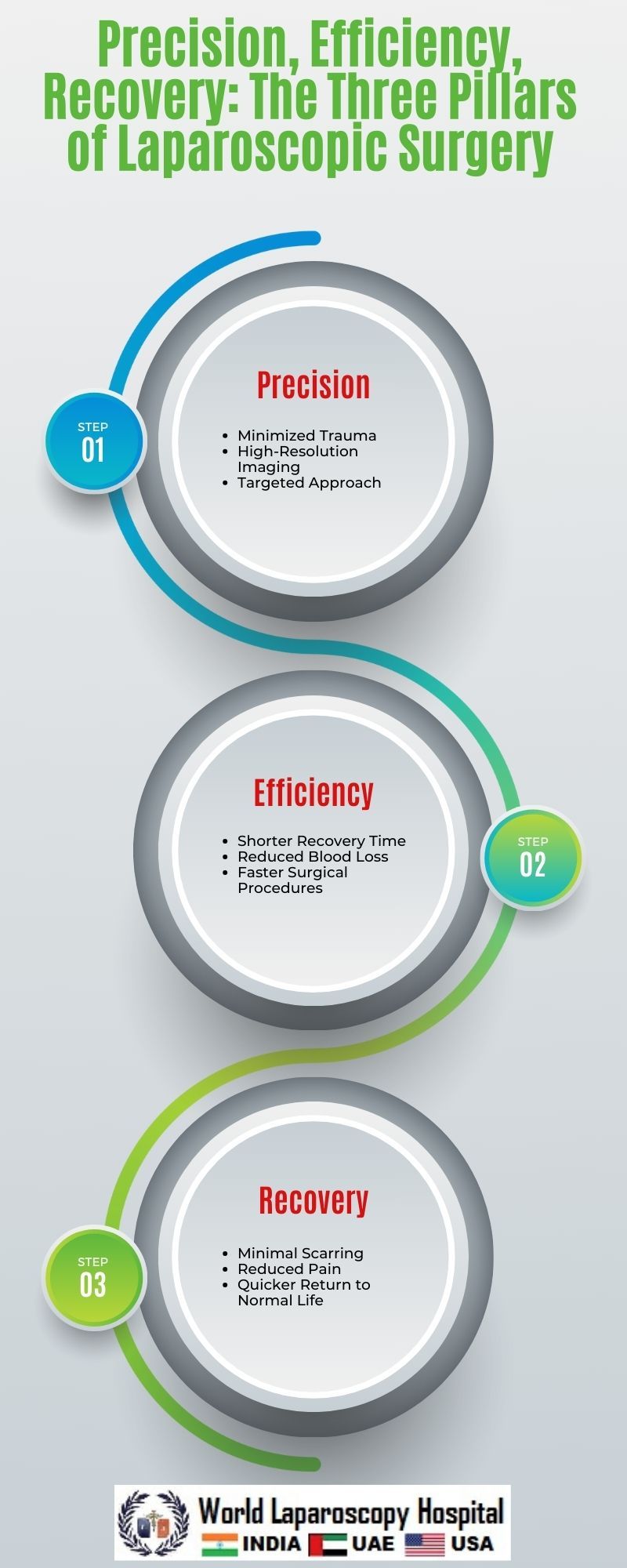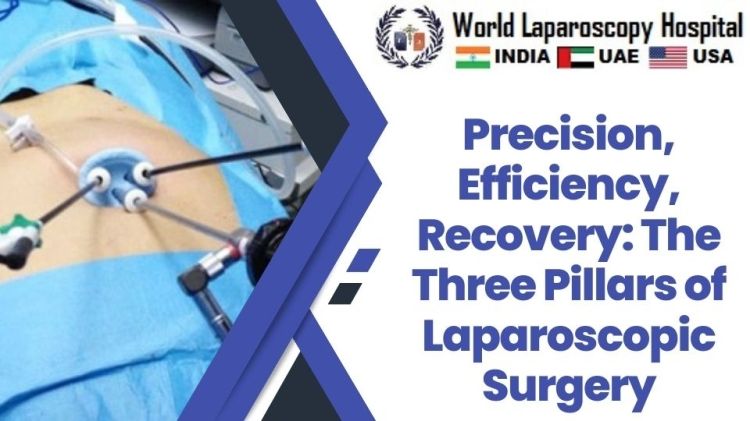Introduction:
Laparoscopic surgery, often referred to as minimally invasive surgery, has revolutionized the field of surgical interventions. This advanced technique involves making small incisions through which specialized instruments and a camera are inserted to perform surgeries with enhanced precision, efficiency, and a focus on rapid recovery. These three pillars—precision, efficiency, and recovery—form the cornerstone of laparoscopic surgery, reshaping the landscape of modern surgical practices.

Precision in Laparoscopic Surgery:
Precision is a fundamental aspect of any surgical procedure, and laparoscopic surgery excels in this regard. Unlike traditional open surgeries, where a large incision is made, laparoscopic procedures involve several small incisions, each serving a specific purpose. The use of high-resolution cameras allows surgeons to visualize the operative field in detail, providing a magnified and illuminated view of internal organs.
Visualization Technology:
One key element contributing to precision in laparoscopic surgery is the advanced visualization technology. The laparoscope, a thin tube equipped with a light source and camera, allows surgeons to navigate and operate within the body with unprecedented clarity. The real-time images transmitted to a monitor guide the surgical team, enabling them to make precise movements and interventions.
Instrumentation and Robotics:Specialized instruments used in laparoscopic surgery are designed to mimic the dexterity of the human hand. These instruments, often controlled by the surgeon from a console, provide a range of motion and articulation that surpasses what is achievable with traditional instruments. Robotic-assisted laparoscopic surgery takes this a step further, with robotic arms being controlled by the surgeon, enhancing precision through finer movements and improved ergonomics.
Reduced Tissue Trauma:The minimally invasive nature of laparoscopic surgery contributes to reduced tissue trauma. Smaller incisions mean less disruption to surrounding tissues and organs. This not only minimizes pain and discomfort for the patient but also accelerates the healing process. Precise incisions and careful manipulation of instruments allow surgeons to target specific areas, reducing the risk of damage to adjacent structures.
Efficiency in Laparoscopic Surgery:
Efficiency is a critical factor in modern healthcare, and laparoscopic surgery has proven to be a highly efficient method for various procedures. The streamlined approach, quicker recovery times, and reduced hospital stays contribute to the overall efficiency of laparoscopic interventions.
Shorter Hospital Stays:
Laparoscopic procedures often result in shorter hospital stays compared to traditional open surgeries. The minimally invasive nature of these surgeries leads to quicker recoveries, enabling patients to return to their daily lives sooner. This not only benefits the patients but also reduces the strain on healthcare resources, allowing for more efficient use of hospital facilities.
Faster Recovery:The reduced trauma to tissues and organs in laparoscopic surgery translates to faster postoperative recovery. Patients experience less pain and discomfort, allowing them to resume normal activities more quickly. Rapid recovery not only enhances patient satisfaction but also contributes to overall healthcare cost-effectiveness by minimizing the need for prolonged postoperative care.
Enhanced Surgical Throughput:Laparoscopic surgery allows for increased surgical throughput, as the minimally invasive approach often results in shorter procedure times. Surgeons, aided by advanced technology and improved instrumentation, can perform surgeries with greater efficiency without compromising precision. This is particularly significant in busy healthcare settings where optimizing surgical schedules is crucial.
Recovery in Laparoscopic Surgery:
The emphasis on patient recovery is a defining characteristic of laparoscopic surgery. From reduced postoperative pain to faster return to normal activities, the focus on recovery sets laparoscopic procedures apart from traditional open surgeries.
Minimized Postoperative Pain:One of the notable benefits of laparoscopic surgery is the minimized postoperative pain experienced by patients. The smaller incisions and reduced tissue trauma result in less pain during the recovery period. This not only improves the patient experience but also reduces the need for postoperative pain management, mitigating the potential side effects associated with pain medications.
Quicker Return to Normal Activities:Laparoscopic surgery enables patients to return to their normal activities more quickly than with open surgeries. The reduced recovery time allows individuals to resume work, exercise, and daily routines sooner, contributing to an improved quality of life. This aspect is particularly significant in the context of elective procedures where minimizing downtime is a priority for many patients.
Cosmetic Considerations:The cosmetic outcomes of laparoscopic surgery are often superior to those of open surgeries. The smaller incisions result in less noticeable scars, promoting a more aesthetically pleasing outcome. This cosmetic advantage is not only a psychological benefit for patients but also a factor that can influence their overall satisfaction with the surgical experience.
Conclusion:
Precision, efficiency, and recovery are the three pillars that define laparoscopic surgery and propel it to the forefront of modern surgical practices. The continual advancements in technology, instrumentation, and surgical techniques further enhance these pillars, ensuring that laparoscopic surgery continues to evolve and provide patients with safer, more effective, and less invasive treatment options. As the field progresses, the impact of laparoscopic surgery on patient outcomes, healthcare efficiency, and the overall landscape of surgical interventions is poised to grow, solidifying its role as a cornerstone in the future of medicine.


